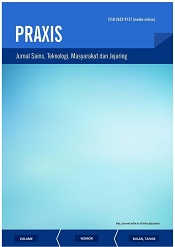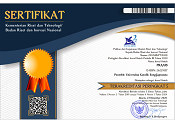Author Guidelines
Petunjuk Umum
Praxis: Jurnal Sains, Teknologi, Masyarakat dan Jejaring memuat artikel hasil penelitian murni ataupun hasil penelitian yang dilakukan dalam kegiatan pengabdian pada masyarakat. Artikel yang diusulkan untuk dimuat dalam Praxis: Jurnal Sains, Teknologi, Masyarakat dan Jejaring haruslah tulisan yang belum pernah dimuat di media lain. Artikel dapat ditulis dalam Bahasa Indonesia atau Bahasa Inggris dengan menggunakan kaidah bahasa tulis yang baik dan benar.
Petunjuk Khusus
Penyusunan naskah dilakukan menurut ketentuan sebagai berikut:
- Penulis bisa individu atau tim.
- Naskah diketik dengan program Microsoft Word, huruf Times New Romans 12pt, 2 kolom, spasi 1.5 pada kertas ukuran A4, margin atas dan bawah 2,5 cm, margin kiri dan kanan 2,5 cm. Jumlah halaman berkisar antara 10 – 15 halaman. Orientasi: Portrait.
- Naskah dapat ditulis dengan menggunakan bahasa Indonesia. Penulisan naskah dilakukan menurut kriteria yang ditentukan oleh American Psychological Association (APA), yang tercantum dalam Publication Manual of The American Psychological Association Edisi ke-6.
- Naskah dapat dikirim melalui : http://journal.unika.ac.id/index.php/praxis, besar file tidak lebih dari 2 MB, disertai dengan biodata penulis dan alamat korespondensi (alamat kantor, alamat rumah, hp, telpon rumah).
- Naskah belum pernah dipublikasikan di jurnal atau media ilmiah lainnya.
- Naskah ilmiah yang dikirimkan merupakan hasil penelitian empirik, pengkajian teoritik, maupun penggabungan antara kedua hal tersebut.
Bagian-bagian NaskahPenulisan bagian-bagian naskah dilakukan menurut ketentuan sebagai berikut:
- Judul : Judul Ditulis Dalam Bahasa Indonesia (Maksimal 13 Kata) ← 14pt, Bold, di MsWord Pilih fitur Capitalize Each Word (Bukan UPPERCASE/HURUF BESAR SEMUA)
- Nama Lengkap Penulis : Nama ditulis lengkap, tanpa singkatan; tanpa gelar.
- Alamat Penulis : Alamat lengkap dan alamat e-mail penulis dicantumkan.
- Abstraksi : Abstraksi ditulis dalam bahasa Indonesia dan bahasa Inggris sekitar 100 - 200 kata. a. Abstrak untuk penelitian empirik harus berisi tujuan, subjek penelitian, metode pengumpulan dan analisis data, hasil penelitian, dan simpulan (dan saran). b. Abstrak untuk naskah nonpenelitian (pengkajian teoritik) terdiri dari topik, tujuan, analisissintesis, dan simpulan.
- Kata Kunci (key words) : Paling banyak terdiri dari 5 kata. Disarankan berbeda dengan yang ada di judul.
- Pendahuluan : Menjelaskan latar belakang dan masalah penelitian.
- Metode : menjelaskan karakteristik responden penelitian dan metode pengumpulan dan analisis data.
- Hasil penelitian : Berisi penjelasan dan pembahasan hasil penelitian. (Tidak ada kutipan)
- Diskusi : Membahas implikasi hasil penelitian.
- Simpulan : Berisi simpulan hasil penelitian.
- Daftar Pustaka : Memuat sumber rujukan penelitian.
Cara Penulisan Sumber Referensi
Penulisan daftar pustaka dan kutipan mengacu pada ketentuan American Psychological Association (APA), yang tercantum dalam Publication Manual of The American Psychological Association Edisi ke-6 (2010).
1. Penulisan Daftar Pustaka
Daftar Pustaka memuat sumber rujukan, yang lebih diprioritaskan 20 tahun terakhir.
a. Tulisan yang berasal dari sumber yang terbit secara periodik (jurnal, majalah, koran)
1) Jurnal dalam bentuk cetak dan elektronik (online)
Herbst-Damm, K.L. (2005). Volunteer support, marital status, and the survival times of terminally ill patients. Health Psychology, 124, 225-229.
Sillick, T.J., & Schutte, N.S. (2006). Emotional Intelligence and self-esteem mediate between perceived early parental love and adult happiness. E-Journal of Applied Psychology, 2(2), 34-48. Retrieved from http:/ojs.lib.swin.edu.au/index.php/ejap.
2) Majalah dalam bentuk cetak dan elektronik (online)
Chamberlin, J., Novotney, A., Packard, E., & Price, M. (2008, May). Enhancing worker wellbeing: Occupational health psychologist convene to share their research on work, stress, and health. Monitor on Psychology, 39(5), 26-29.
Clay, R. (2008, June). Science vs. ideology: Psychologist fight back about the misuse of research. Monitor on Psychology, 39(6). Retrieved from http://www/apa.org/ monitor/
3) Koran dalam bentuk cetak dan elektronik (online)
Schwartz, J. (1993, September 30). Obesity affects economic, social status. The Washington Post, pp. A1, A4.Retrieved from http://nytimes.com.
4) Tulisan yang bersumber dari abstrak dalam bentuk cetak dan elektronik
Woolf, N.J., Young, S.L., Fanselow, M.S., & Butcher, L.L. (1991). MAP-2 expression in choliboceptive pyramidal cells of rodent cortex and hippocampus is alterded by Pavlovian conditioning [Abstract]. Society for Neuroscience Abstracts, 17, 480.
Lassen, S.R., Steele, M.M., & Sailor, W. (2006). The relationship of school-wide positive behavior suppport to academic achievement in urban middle school. Psychology in the schools, 43, 701-712. Abstract retrieved from http:/www.interscience.wiley.com.
b. Tulisan yang berasal dari sumber yang tidak terbit secara periodik (buku, laporan, brosur, monograph, manual, dan media audiovisual)
1) Buku dalam bentuk cetak
Shotton, M.A. (1989). Computer addiction? A study of computer dependency. London, England: Taylof & Francis.
Beck, C.A.J., & Sales, B.D. (2001). Family mediation: Facts, myths, and future prospects. Washington, DC: American Psychological Association.
Mitchell, T.T., & Larson, J.R., Jr. (1987). People in organizations: An introducti-on to organizational behavior (3rd ed.). New York: McGraw-Hill.
Haybron, D.M. (2008). Philosophy and the science of subjective well-being. In M. Eid & R. J. Larsen (Eds.). The science of subjective well-being (pp. 17-43). New York, NY: Guilford Press.
2) Versi elektronik dari buku yang dicetak
Shotton, M.A. (1989). Computer addiction? A study of computer dependency. [DX Reader version]. Retrieved from http://www.ebookstore.tandf.co.uk/html/index.asp
3) Buku yang dipublikasikan hanya dalam bentuk elektronik
O’keefe, E. (n.d.) Egoism & the crisis in Western values. Retrieved from http://www.onlineoriginals.com/showitem.asp?itemID=135
4) Buku referensi dalam bentuk cetak
VandenBos, G.R. (Ed.). (2007). APA dictionary of psychology. Washington DC: American Psychological Association
5) Buku referensi dalam bentuk elektronik (online)
Graham, G. (2005). Behaviorism. In E. N. Zalta (Ed), The Stanford encyclopedia of philosophy (Fall 2007 ed.) Retrieved from http://plato.stanford.edu/entries/behabehavio/
6) Laporan organisasi pemerintah dalam versi elektronik (online)
U.S. Department of Health and Human Services, National Institutes of Health, National Heart, Lung, and Blood Institute. (2003). Managing asthma: A guide for schools (NIH Publication No. 02-2650). Retrieved from http://www.nhlbi.nih.gov/ health/prof/ lung/asthma/asth_sch.pdf
7) Naskah dari simposium
Muelbauer, J. (2007, September). Housing, credit, and consumer expenditure. In S. C. Ludvigson (Chair), Housing and consumer behavior. Symposium conducted at the meeting of the Federal Reserve Bank of Kansas City, Jackson Hole, WY.
8) Disertasi Doktoral dan tesis Magister yang tidak dipublikasikan
Wilfley, D.E. (1989). Interpersonal analyses of bulimia: Normal-weight and obese. Unpublished doctoral dissertation, University of Missouri, Columbia
9) Disertasi Doktoral dan tesis Magister dari sumber elektronik
Adams, R.J. (1973). Building a foundation for evaluation of instruction in higher education and continuing education (Doctoral dissertation). Retrieved from http://www.ohiolink.edu/etd/
McNiel, D.S. (2006). Meaning through narrative: A personal narrative discussing growing up with an alcoholic mother (Master’s thesis). Available from Proquest Dissertations and Theses database. (UMI No. 1434728).
2. Penulisan Kutipan
Naskah dengan dua penulis, maka semua penulis dicantumkan. Jika naskah ditulis oleh dua sampai lima penulis, untuk kutipan pertama mencantumkan semua nama penulis. Pada kutipan selanjutnya ditulis nama penulis pertama, kemudian diikuti dkk. Jika naskah ditulis oleh lebih dari lima orang maka hanya penulis pertama yang dicantumkan, dan selanjutnya ditulis dkk.
a. Kutipan yang bersumber dari satu penulis:
- Kessler (2003) found that among epidemiological samples
- Early onset results in a more persistent and severe course (Kessler, 2003).
- In 2003, Kessler’s study of epidemiological samples showed that …
b. Kutipan yang bersumber dari beberapa penulis:
Kutipan dari dua penulis:
- As Kurtines and Szapocznik (2003) demonstrated …
- As has been shown (Joreskog & Sorbom, 1989) … Kutipan penulis sampai lima orang
- Kisangau, Lyaruu, Hosea, and Joseph (2007) found [use as first citation in text]
- Kisangau dkk. (2007) found [use as subsequent first citation per paragraph thereafter]







